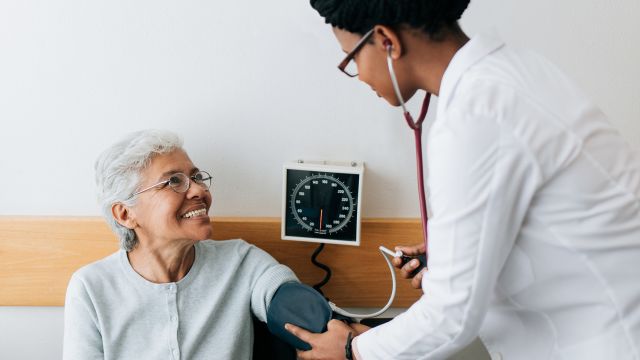Updated on December 11, 2024.
Blood pressure that’s usually normal but becomes elevated in the office of a healthcare provider (HCP) is a possible warning sign of heart trouble that shouldn’t be ignored.
This phenomenon, known as “white coat hypertension” (since doctors typically wear white lab coats), was once generally dismissed as a temporary issue related to the stress or anxiety of a medical visit. But a growing body of evidence challenges this view.
What is white coat hypertension?
When a person visits an HCP’s office and has their blood pressure measured, they may feel anxious about the appointment. Perhaps they’re concerned about a health issue, they’re uncomfortable in medical environments, or something else about the visit is causing them to worry.
Regardless, this anxiety can cause blood pressure to rise. People with white coat hypertension have high blood pressure at the doctor’s office, but if measured at home, it’s within a normal range.
Signs of a larger health issue
Experts have long worried that white coat hypertension could lead to unnecessary treatment. If a person is diagnosed with high blood pressure at an HCP's office, they may be given medications to lower it, when in fact their blood pressure is normal. If it isn’t double-checked with readings taken outside a clinical environment, they may receive medications they don’t need, or at a higher dosage than they need.
While white coat hypertension shouldn’t necessarily be taken at face value, some research suggests that it also shouldn’t be ignored. For example, untreated white coat hypertension was linked to a small but real increased risk for heart attack and early death in a 2024 review published in Current Hypertension Reports. Similarly, in 2019, a systematic review and meta-analysis published in Annals of Internal Medicine linked it to an increased risk of death and serious heart issues.
Why might this be the case? The reasoning goes that white coat hypertension may signal that a person is prone to unstable blood pressure, which can have an effect on the health of blood vessels and the heart. If a patient's blood pressure is affected by the anxiety of seeing an HCP, it's likely affected by many other factors.
However, it’s worth pointing out that not all research has the same findings. A large-scale 2023 study published in Postgraduate Medicine followed nearly 60,000 people for about 10 years and found no link between white coat hypertension and increased risk of cardiovascular death or death from any causes.
Regardless, expert panels, including the U.S. Preventive Services Task Force (USPSTF), recommend out-of-office blood pressure screening to confirm a diagnosis of white coat hypertension before treatment for high blood pressure begins.
Monitoring blood pressure outside an HCP office
At-home blood pressure monitoring is a good way to help manage your blood pressure. It may also provide a more accurate picture of your blood pressure than occasional measurements taken at the HCP’s office, which may produce the white coat effect. Studies show that home measurements, when taken correctly, are better predictors of cardiovascular risk than office measurements.
There are other benefits, as well. Self-monitoring may also be used to help assess how well medications or lifestyle modifications are working. And there is evidence to suggest that home monitoring may help people reduce their blood pressure.
The best way to track your blood pressure yourself is with a home blood pressure monitor. Using the device, you can take multiple readings each day, or as often as you need.
Once you’ve measured, you can keep track of your systolic and diastolic numbers using the Sharecare app (available through iOS and Android). Convenient and easy to use, it tells you whether your reading is healthy, and helps you recognize changes over time—important for detecting conditions like hypertension.
Choose the right blood pressure monitoring device
There are so many devices on the market for measuring blood pressure at home that it can be difficult to know which one to choose. Most people who measure their blood pressure at home use an automatic machine with a digital display. Many find that these devices are simple to use. The cuff inflates and deflates automatically, the numbers are clear and easy to read, and many machines can store and print multiple blood pressure readings. But they do have their downsides. Some are made for use on the left arm only, and they can be expensive.
Here are a few simple guidelines to help you choose the right blood pressure monitoring device:
- Choose a device that measures blood pressure from your upper arm. Wrist and finger monitors are not accurate.
- Choose a monitor with a display that's easy for you to read.
- A monitor that can save, download, and print your readings is best for accurate record-keeping.
Before you buy, verify that the monitor you're considering has been independently tested, validated, and approved for home use.
Once you've bought a measuring device, make an appointment with your HCP and take the device with you. That way, if you have any questions about home monitoring or how to read blood pressure numbers, your HCP can provide guidance. Also, some monitors need to be calibrated or checked for accuracy on a regular basis. Your HCP should be able to do this for you.
For more detailed information on choosing and using a home blood pressure monitor, check out information from the American Heart Association.
Keeping an eye on your blood pressure is an easy and effective way to monitor your health and prevent high blood pressure from sneaking up on you.







